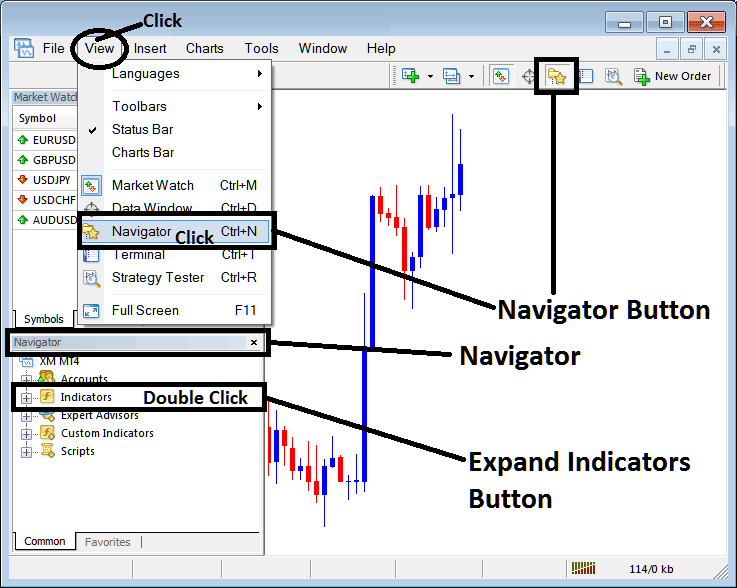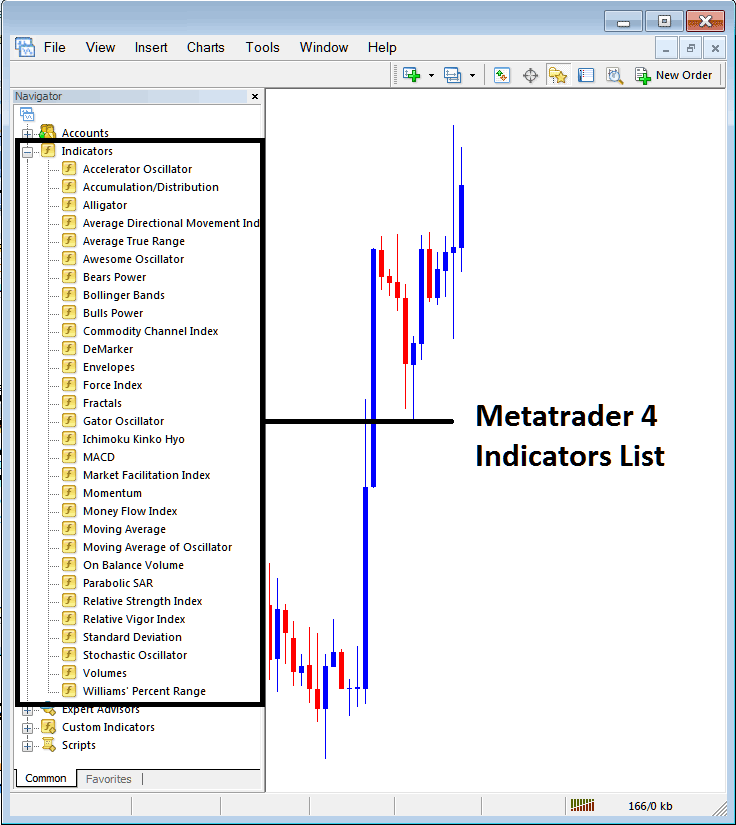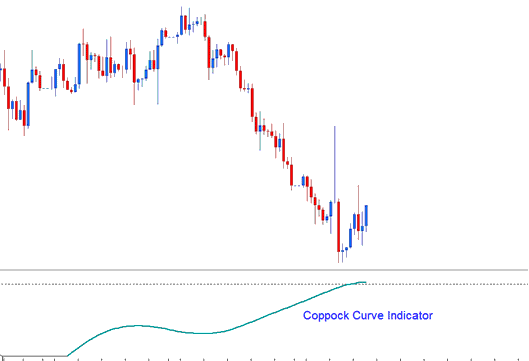How to Set MetaTrader 5 Coppock Curve on MetaTrader 5 Charts
Step 1: Open MT5 Software Platform Navigator Window
Open MT5 Navigator window as presented on the MT5 illustration put on display below: Go to 'View' menu (press), then select the 'Navigator' window (press), or From Standard Toolbar click the 'Navigator' button or press key board MetaTrader 5 shortcut keys 'Ctrl+N'
On MT5 Navigator window, choose and select "Indicators", by Double Clicking

How Do You Use MT5 Coppock Curve in the MT5?
How to Set Coppock Curve MT5 Indicator
Expand this menu by pressing the protract(+) button "+" or doubleclick the 'indicators' menu, afterwards this particular specified button will be displayed as (-) & will now display MetaTrader 5 indicators list as presented on the MT5 illustration below - select the Coppock Curve from this list of MT5 indicators so that as you as a trader can add the Coppock Curve MT5 indicator in the MT5 chart.

How Do You Use MetaTrader 5 Coppock Curve on MT5 Software Platform?
How to Add Custom Coppock Curve in Meta Trader 5
If the MT5 indicator that you want to add in the MetaTrader 5 charts is a custom MT5 technical indicator - for example if the Coppock Curve that you want to add is a custom MetaTrader 5 technical indicator you will need to first add this custom Coppock Curve MT5 indicator in the MetaTrader 5 software & then compile custom Coppock Curve so that as the newly added Coppock Curve MT5 custom indicator pops up on the list of custom indicators on the MetaTrader 5 platform.
To learn how to add Coppock Curve indicators on MT5 software - how do you place Coppock Curve panel to MT5 software? - how do you place Coppock Curve custom technical indicator on MetaTrader 5 software? - How to add custom Coppock Curve custom indicator on the MT5 Software.
How Do You Use Coppock Curve MT5 Indicator?
Coppock Curve Analysis Buy & Sell Signals
Developed by Edwin Sedgwick Coppock
Coppock Curve technical analysis.

How to Set MetaTrader 5 Coppock Curve Trading Indicator on MetaTrader 5 Charts
The principle behind Coppock Curve is the psychology of trading forex, based on the theory that human habit-is predictable. And the price movement always oscillates in a zigzag kind of manner.
The principle of adaptation levels applies to how the price reacts at certain levels - prices will react in the same way or same pattern as those same market patterns observed historically.
How to Generate Buy & Sell Signals
The MA indicator in trading forex is the simplest form of an adaptation levels, the price will oscillate around the MA. This forms the basis of this indicator, which is a longer-term oscillator technical indicator based on this adaptation levels (moving average), but is used in a different way.
Oscillators indicators generally begin by calculating a % change of the current price point from some previous selected market price point - where previous price point that was used is the reference point (adaptation-levels).
Edwin Coppock when he created this technical indicator argued and reasoned that the market participants' emotional state could be quantified & analyzed by summing and adding up the % changes over the recent past to get a general sense of the market's longer-term trend momentum.
Signals can also be generated using the Coppock Curve to trade market trend reversals from extreme price levels. Looking for divergence trading setups & trend-line breaks may also be combined to confirm the signals derived/generated by this Coppock Curve indicator.
Implementation of Coppock Curve Technical Indicator
Coppock Curve has got a zero line reference point - but this reference point doesn't represent the adaptation-level but it's only a used as reference point only for generating buy and sell signals.
How Do You Use MT5 Coppock Curve on the MT5?
Get More Courses and Topics:


